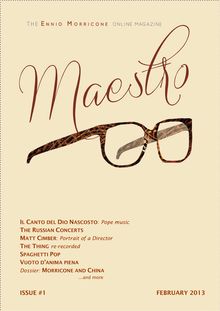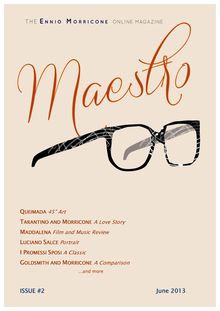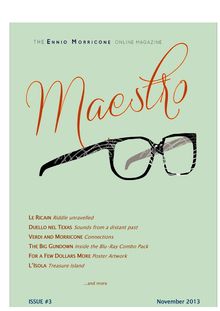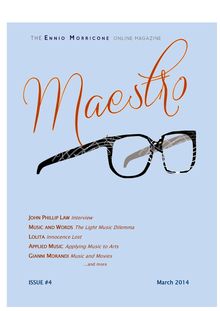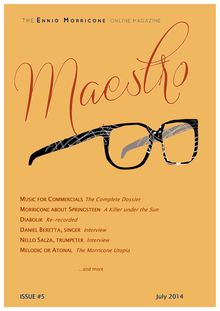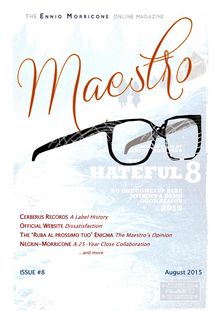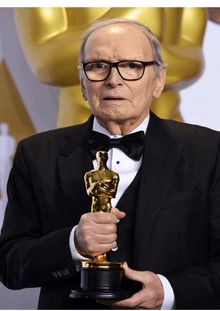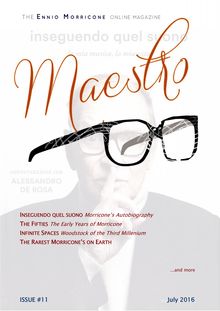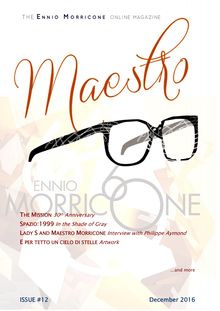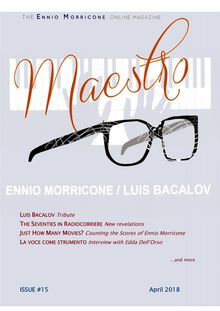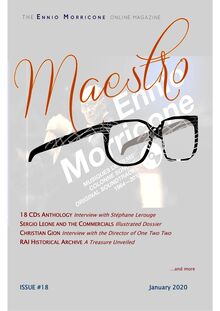-
 Univers
Univers
-
 Ebooks
Ebooks
-
 Livres audio
Livres audio
-
 Presse
Presse
-
 Podcasts
Podcasts
-
 BD
BD
-
 Documents
Documents
-
- Cours
- Révisions
- Ressources pédagogiques
- Sciences de l’éducation
- Manuels scolaires
- Langues
- Travaux de classe
- Annales de BEP
- Etudes supérieures
- Maternelle et primaire
- Fiches de lecture
- Orientation scolaire
- Méthodologie
- Corrigés de devoir
- Annales d’examens et concours
- Annales du bac
- Annales du brevet
- Rapports de stage
La lecture à portée de main
Tout savoir sur nos offres
Tout savoir sur nos offres

Description
NEWS: In breve, Old News, Feedback from Previous Issues - Patrick Bouster, Didier Thunus, Frédéric Durand, Richard Bechet (5-15)
IN MEMORIAM: Luis Bacalov (1933-2017) - Didier Thunus (16-20)
DOSSIER: The Seventies in Radiocorriere, Part 1: The Television - Frédéric Durand (21-34)
ODDITY: Who is Florinda Bolkan? Very short consideration about the influence of pre-existing music in a musical composition - Enrico Tichelio (35-36)
ANALYSIS: The Seventies Arrangements - Steven Dixon (37-42)
SCORE REVIEW: La corrispondenza - Randolph Carter (43-46)
IN MEMORIAM: To Folco - Patrick Bouster and Mario Italia (47-48)
INTERVIEW: La voce come strumento: Intervista a Edda Dell'Orso - Mattia Marzi per rockol.it (49-52)
TRIVIA: Just How Many Movies? Counting the Scores of Ennio Morricone - Didier Thunus (53-60)
ARRANGEMENTS: Aznavour Italiano, “Per la vita” - Patrick Bouster (61-67)
Sujets
Informations
| Publié par | didier_thunus |
| Publié le | 18 mai 2018 |
| Nombre de lectures | 20 |
| Licence : |
En savoir + Paternité, pas d'utilisation commerciale, partage des conditions initiales à l'identique
|
| Langue | English |
| Poids de l'ouvrage | 3 Mo |
Extrait
LUIS BACALOV Tribute
THE SEVENTIES IN RADIOCORRIERE New revelations
JUST HOW MANY MOVIES? Counting the Scores of Ennio Morricone
LA VOCE COME STRUMENTO Interview with Edda Dell Orso
...and more
ISSUE #15 April 2018MAESTRO – THE ENNIO MORRICONE ONLINE MAGAZINE ISSUE #15 APRIL 2018
Table of Contents
Preface: Ennio’s Correspondence .............................................................................................. 3
In breve....................................................................... 5
Old News.. 10
Feedback from Previous Issues ................................................................ 15
Luis Bacalov (1933-2017)........................................ 16
The Seventies in Radiocorriere, Part 1: The Television.......................... 21
Who is Florinda Bolkan? Very short consideration about the influence of pre-existing music in
a musical composition.............................................................................................................. 35
The Seventies Arrangements.... 37
La corrispondenza.................... 43
To Folco ................................................................................................................................... 47
La voce come strumento: Intervista a Edda Dell'Orso............................. 49
Just How Many Movies? Counting the Scores of Ennio Morricone........ 53
Aznavour Italiano: “Per la vita” ............................................................................................... 61
License for all articles: CreativeCommons
Cette œuvre est mise à disposition selon les termes de la Licence Creative Commons Attribution
- Pas d’Utilisation Commerciale - Partage dans les Mêmes Conditions 2.0 Belgique
PUBLICATION PÉRIODIQUE D'ÉTUDE ET DE CRITIQUE DANS LE DOMAINE ARTISTIQUE. LES TEXTES
SONT PUBLIÉS SOUS LA RESPONSABILITÉ DE LEURS AUTEURS, QUI EN CONSERVENT LA PROPRIÉTÉ
DES DROITS D'AUTEUR ET INTELLECTUELS.
All the articles are of purely informative nature. We do not own the copyright of the images
included in this document or of the audio clips accessible from it. All the rights on the images
and the music are the property of their respective owners.
Chief editors: Patrick Bouster and Didier Thunus
Front cover design: Valeria Magyar
Front cover inlay: Anne-Catherine Mortiaux
Front cover image: Partial cover design of vinyl-LP “Per amore” RCA TBL1 1234 (1976)
2MAESTRO – THE ENNIO MORRICONE ONLINE MAGAZINE ISSUE #15 APRIL 2018
P REFACE
Ennios Correspondence
by Didier Thunus
I was deeply moved when I saw the movie La corrispondenza. Not that I am an unconditional fan of
Giuseppe Tornatore’s movies: even though each of them carries the undeniable mark of a very gifted
director, many of his films have left me cold. Others however are top-drawer works of art, and not only the
unanimously lauded Cinema Paradiso: my preferences go to the dark Una pura formalità, and the truly
remarkable La migliore offertà. La corrispondenza works on a different level however, as it tickles the
human soul on very intimate aspects. This movie is about love and death, and therefore triggers very
personal feelings. It is bound to touch each and every one very differently. And judging from the meek
reception when the film came out, we can say that it didn’t work likewise for everybody.
I hate spoilers but I have to say at least that the story is about a woman who keeps receiving messages from
her beloved even after his death. The images of Olga Kurylenko relentlessly searching for the truth through
the streets of Rome or Edinburgh, and the mists of the lago d’Orta, kept haunting me for days and weeks
afterwards.
I felt that we were far from having treated the subject of La corrispondenza substantially enough in this
fanzine – apart from Patrick’s article upon the release of the movie (see Maestro #10), which was the least
we could do. However, as co-chief editor of a fanzine exclusively based on the free will of contributors,
praiseworthy as these may be, I cannot go out and impose any subject for an article. Therefore, I was more
than happy when I received a message from our faithful Randolph Carter. Not because the real Randolph
1Carter is dead and is still sending messages to me. Definitely not: our own personal Randolph Carter is
alive and well and you will be able to judge this for yourself by reading his customarily clever and informed
writing in the pages that below. No, I was happy because we were granted with an excellent and elaborate
review of La corrispondenza by our finest writer for this new issue of Maestro, finally doing justice to
this masterpiece.
The music by Ennio Morricone of course offers as usual the perfect counterpoint to this moving story. I do
not want to interfere with Mr. Carter’s own testimonial below, but I’d still like to say a few words about
the piece Una stella, milliardi di stelle: a thirteen minute piece of exquisite music. To say that it is repetitive
is an understatement: it is nothing else than 11 repetitions of a section of 1:15, itself made up of 8 cells of
twice the same 4 notes (except for the last of the 8 pairs, playing the role of a conclusion, where the notes
slightly differ between its 2 parts).
Una stella, milliardi di stelle – Ennio Morricone
Each of the first repetitions adds an element: it starts with a solo piano, then electric guitars chords are
added, then synths, a bass (I don’t know many pieces where the bass enters after 6 minutes). Then it settles
with this gathering until the end.
1 You never know this for sure when it comes to a fictitious character, but since he was some sort of alter ego to
his author H.P. Lovecraft, we can assume that he is.
3MAESTRO – THE ENNIO MORRICONE ONLINE MAGAZINE ISSUE #15 APRIL 2018
People say it’s too long. But how can a 13-minute massage be too long? How can 13-minute lovemaking
with the partner of your dreams be too long? I personally find it too short, if anything. Ennio had already
gratified us with a comparable piece just a few months before, in the form of the eponymous track from En
mai fais ce qu’il te plaît. The idea was similar, but a splendid strings melody was added in counterpoint
after a while. Another masterpiece.
I was glad to see Randolph Carter (and then I’ll stop tattling, I promise) comparing the sound of the guitar
to that of Pink Floyd, in that piece and in others. I find it somewhat funny that, for Morricone, trying to
sound “modern” – because this is what the plot implied and what Tornatore must have asked him – meant
sounding like Pink Floyd or Dire Straits. Those “younger” artists have probably kept, to the ears of the
Maestro, the stature of archetype of modern music. Whatever the case, it works and the result is splendid.
In these guitar pieces, we can only praise the inspired playing of guitarists Rocco Zifarelli and Nanni
Civitenga, perfectly embodying the Maestro’s intents.
This reminded me of the moment I saw that Ennio Morricone and Roger Waters were working together,
back in 1998. Also for a Tornatore movie by the way: La leggenda del pianista sull'oceano. I was
fascinated by this piece of news, and the sounds that anticipatively came to my mind were exactly what we
now got to hear in La corrispondenza. Indeed I had to wait for 18 years, because in 1998, the deception
was big when I saw that this very promising collaboration had been limited to one song, and that the two
“monsters” had not even met. To tell the truth, we were able to briefly enjoy this kind of sound already
inside the piece Di notte from In fondo al cuore, dated 1997 but released only in 2006.
But to go back to the heart of this preface, I couldn’t help thinking that we can also parallel this plot with
our own experience of the Maestro’s music: sure enough, we will still receive “messages” from beyond the
tomb from our favourite composer. Not that this date looks any close – on the contrary, the man seems to
be pushing away every usual sign of aging. These messages will take the form of late releases of unreleased
pieces (and there are still many), of inheritance of his legacy in younger composers’ music, of revisiting his
past works, of additions to his filmography and discography. Today already, before you finish reading this
issue of Maestro, you will have learned about no less than three movies to be added to the list. We can be
sure also that Morricone was already very active from the Fifties onwards, even though the body of his
work only started to be known from the Sixties. Based on our current knowledge, his production seems to
have culminated between 1965 and 1974 – however there is no reason to believe that he was working less
between 1950 and 1964, quite the contrary.
So there is still a lot of correspondence to be published, and this fanzine will humbly try to play the role of
messenger.
Now I will let you discover the very varied contents of this new issue, not without telling you one last piece
of information: Ennio is already no longer the oldest artist to have received an Oscar. Screenwriter James
Ivory just won the statuette for Call Me by Your Name, at the age of 89. Congratulations to him!
4MAESTRO
-
 Univers
Univers
-
 Ebooks
Ebooks
-
 Livres audio
Livres audio
-
 Presse
Presse
-
 Podcasts
Podcasts
-
 BD
BD
-
 Documents
Documents
-
Jeunesse
-
Littérature
-
Ressources professionnelles
-
Santé et bien-être
-
Savoirs
-
Education
-
Loisirs et hobbies
-
Art, musique et cinéma
-
Actualité et débat de société
-
Jeunesse
-
Littérature
-
Ressources professionnelles
-
Santé et bien-être
-
Savoirs
-
Education
-
Loisirs et hobbies
-
Art, musique et cinéma
-
Actualité et débat de société
-
Actualités
-
Lifestyle
-
Presse jeunesse
-
Presse professionnelle
-
Pratique
-
Presse sportive
-
Presse internationale
-
Culture & Médias
-
Action et Aventures
-
Science-fiction et Fantasy
-
Société
-
Jeunesse
-
Littérature
-
Ressources professionnelles
-
Santé et bien-être
-
Savoirs
-
Education
-
Loisirs et hobbies
-
Art, musique et cinéma
-
Actualité et débat de société
- Cours
- Révisions
- Ressources pédagogiques
- Sciences de l’éducation
- Manuels scolaires
- Langues
- Travaux de classe
- Annales de BEP
- Etudes supérieures
- Maternelle et primaire
- Fiches de lecture
- Orientation scolaire
- Méthodologie
- Corrigés de devoir
- Annales d’examens et concours
- Annales du bac
- Annales du brevet
- Rapports de stage
